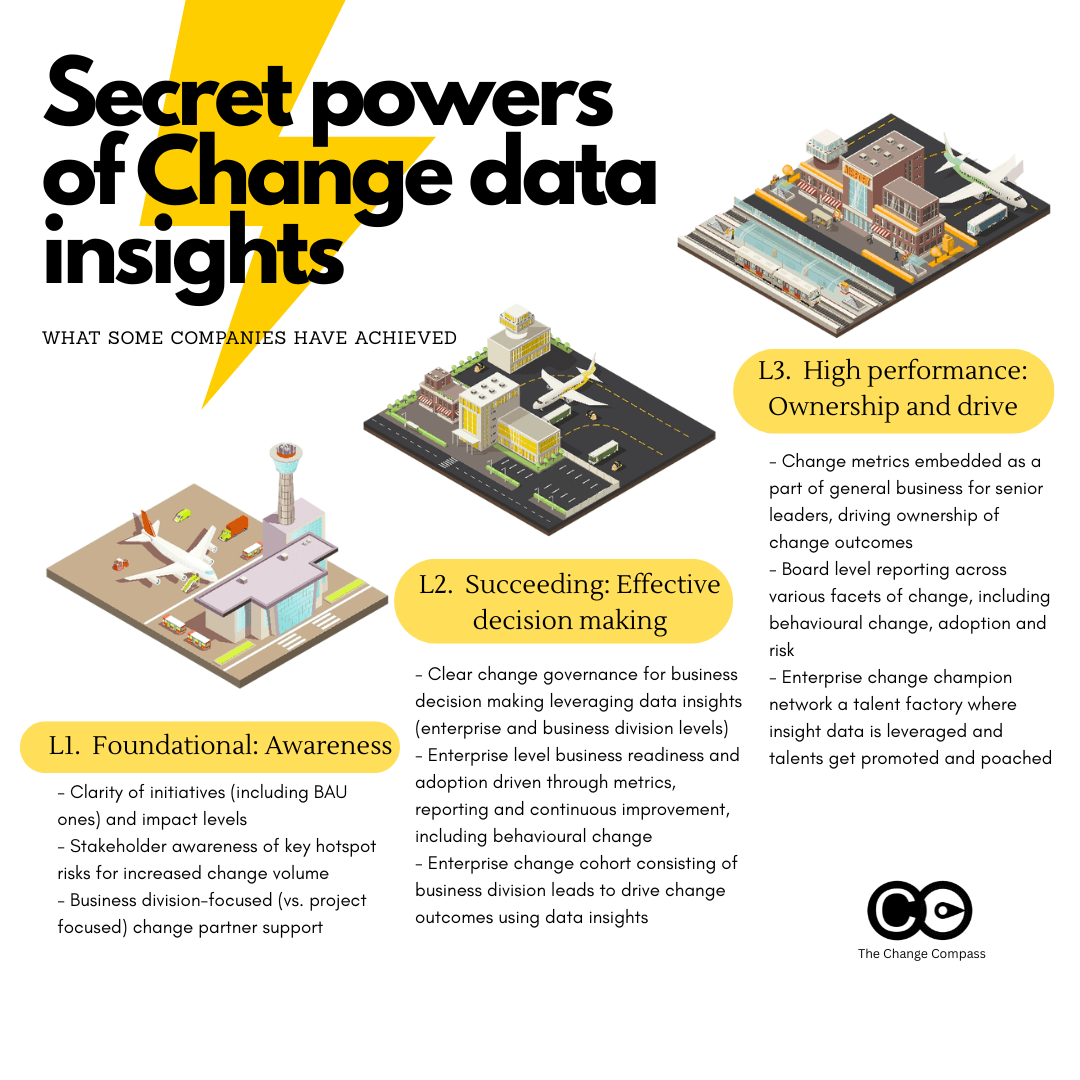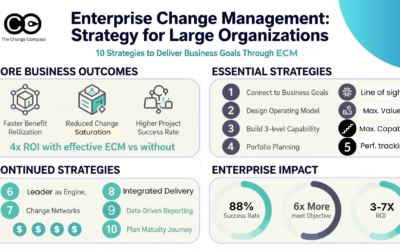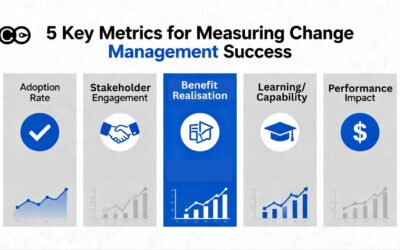Why Change Data is the Hidden Superpower Every Business Leader Needs
The Untapped Potential of Change Data
For years, many senior leaders have viewed organisational change as an art, a blend of communications, stakeholder engagement, and leadership sponsorship. While these elements remain vital, something extraordinary has been unfolding under the surface: the rise of change data as a strategic asset.
What if the way we think of change is too small? What if, instead of treating it as a series of projects that need “change management,” we began to see the data generated by these efforts as a strategic lens into how organisations actually function, adapt, and perform?
Across industries, and over the years, we’ve observed first-hand that when organisations begin to harness change data, the outcomes go far beyond “project readiness.” They reshape how leaders make strategic decisions, how work gets done across divisions, and even how the board manages overall business performance.
The true, and often underestimated, secret is this: change data is not just about preparing people for change. It is about transforming the way an organisation leads, manages, and grows.
This article explores how organisations have unlocked these secret powers, and why senior change and transformation practitioners cannot afford to overlook them. In this part, we’ll uncover the foundational role change data plays in shifting mindsets, supporting readiness, and laying the groundwork for enterprise maturity.
Why Change Data Matters More Than Ever
Let’s start with the bigger picture. Today’s organisations face constant transformation: digital initiatives, regulatory adjustments, product innovation, workforce re-skilling, operational efficiency drives, sustainability imperatives, mergers, and more. The volume, speed, and complexity of change is not slowing down.
Most organisations respond by mobilising structured change management practices at the project level. This includes communication strategies, training, stakeholder maps, and readiness assessments. Valuable, yes — but only a narrow slice of the full change impact picture.
What we’ve noticed is that change practitioners typically begin their data journey seeking to address change readiness and saturation, focusing on questions such as:
- What initiatives are happening when, and where are they hitting the same stakeholder groups?
- How much change are people experiencing at any given time?
- Are there upcoming “hot spots” where the risk of overload or disruption is high?
These are good starting points, and addressing them immediately reduces risk and helps leaders and workforce groups feel supported. But this is only the tip of the iceberg.
The deeper value, the secret power of change data, is how it enables organisations to:
- Redesign structures of work to better support people through business change. For example, moving from purely project-focused change roles to embedded business change partners, who carry insights across initiatives.
- Prepare leaders far more effectively. Division executives who receive targeted change data can anticipate disruption, balance transformation with business-as-usual priorities, and sequence initiatives in ways that protect performance while still delivering progress.
- Elevate organisational conversations. At the enterprise level, change data doesn’t just observe disruption; it enables executives to evaluate trade-offs between delivery performance vs. business performance risks.
Put simply: change data transforms transformation — because it turns change into something tangible, measurable, and ultimately manageable at scale.
The First Unlock: Readiness and Saturation Data
Most organisations begin their change data journey addressing two of the most persistent pain points in transformation:
- Readiness: Are stakeholders equipped and prepared for upcoming changes?
- Saturation: Are people experiencing too much change across overlapping initiatives?
Without data, answers to these questions often rely on perception, anecdote, or late-stage feedback. This reactive approach leads to the classic symptoms of change fatigue: low morale, declining adoption, higher resistance, and frustrated leaders.
When organisations start capturing and reporting change data, however, the picture changes. Suddenly leaders see clear visibility of:
- Change calendars that reveal how shifts overlap across projects and BAU activities.
- Impact mapping that shows who is affected by what, when, and to what degree.
- Hot spot reports that flag functions or business units at risk of overload.
This creates an immediate shift in dialogue. Where once change fatigue was a nebulous concern, leaders now have transparent indicators that guide practical actions like:
- Adjusting timelines to avoid overload.
- Sequencing initiatives so that employees face logical, not chaotic, transitions.
- Allocating resources more intelligently to at-risk teams or functions.
In other words, readiness and saturation data gives leaders evidence-driven tools to manage complexity proactively, not reactively.
From Project Silos to Business Division-Level Change Partnership
However, the story does not end here. After building this readiness and saturation visibility, many organisations realise another breakthrough: change data encourages structural innovation in how change support is delivered.
Traditionally, change management capability is tied closely to individual projects. Each initiative brings in dedicated change resources, who manage impacts and adoption within their project scope. While effective at the micro-level, this creates silos: each project optimises for itself, but no one is accountable for the end-to-end employee experience across multiple changes.
By analysing change data across initiatives, organisations discover the opportunity to reorganise change capability around the business division, not the project. This leads to the creation of business change partners — roles embedded within divisions who leverage data insights to prioritise, balance, and guide cumulative change impact.
This structural shift is powerful because it:
- Ensures continuity across initiatives and prevents duplication of stakeholder engagement.
- Aligns change work to business priorities and outcomes, not only project metrics.
- Provides leaders with trusted advisors embedded in their unit, armed with data describing the total reality of their workforce’s experience.
The impact is transformative. Instead of asking “How do we implement change for this project?” business units start asking “How do we optimise how change lands in our world over the next quarter or year?”.
This is where change management is no longer as a functional service, but as a strategic business capability.
Empowering Leaders to Anticipate and Design Around Change
The shift continues when organisational leaders, especially division heads, receive change data in usable, digestible forms. Suddenly, leadership conversations broaden from project execution to strategic performance.
When data is available, leaders:
- Plan BAU activities with foresight. Instead of being blindsided by overlapping project timelines, they can stage internal improvements and initiatives so that business-critical periods (sales peaks, new product launches, market shifts) are not disrupted.
- Balance business and transformation goals. With saturation hot spots visible, leaders can argue not only for speed but for sustainable adoption. This reframes transformation success as not just “delivered on time” but “delivered without degrading business performance.”
- Design end-to-end transitions at the human level. When you know how employees are being impacted across multiple concurrent initiatives, you can tailor support and reduce fatigue in ways that would never be possible from a single-project lens.
In our experience, these leader-level conversations often spark “lightbulb moments.” Suddenly, senior executives realise change management is not solely about comms and training, it is a strategic enabler of business continuity and performance in times of transformation.
Setting the Stage: The Secret Power of Enterprise-Level Insights
Everything we’ve covered so far, readiness, saturation, structural redesign, business partnership, leader foresight, is just the beginning. These are the foundational benefits organisations experience as soon as they begin systematically capturing and working with change data.
But the real transformation happens when this data scales up to the enterprise level. At this scale, change data becomes a cross-enterprise performance management tool, providing clarity into adoption levels, risk balancing, and even what drives successful behaviour change.
For executives who constantly say “our people are our most important asset,” this is the moment where data finally converts that rhetoric into measurable insights about how people truly experience and deliver change.
From Insights to Impact – How Change Data Transforms Leadership, Governance, and Enterprise Decision-Making
Introduction: Moving from Local Impact to Enterprise Strategy
In the previous section, we explored how organisations begin their journey with change data, tackling readiness and saturation, experimenting with structural improvements like business change partners, and empowering division leaders to design change around business realities. These steps are critical foundations.
But at a certain point, the implications of change data begin to transcend the local or divisional lens. When aggregated and applied effectively, change data becomes a strategic capability at the enterprise level.
At this stage, executives and boards use change insights not only to manage risk but to actively optimise transformation success, protect business performance, and steer organisational strategy in real time.
This marks the transition from using data tactically to leveraging it as part of enterprise governance and maturity. In this part, we’ll explore how organisations use change data to:
- Drive effective enterprise and division-level decision-making.
- Establish performance-driven governance using change insights.
- Embed enterprise adoption, behaviour, and performance metrics.
- Create leadership forums and cohorts dedicated to leveraging change data.
Enterprise-Level Decision Making: Balancing Change Risk with Business Performance
Most organisations are adept at managing delivery risk: risks to timelines, budgets, scope, and quality. But what about business performance risks that emerge when too much change hits the organisation at once, or when leaders underestimate the adoption curve required to translate “delivered” into “realised” outcomes?
This is where change data serves as a powerful balancing mechanism between delivery ambition and business reality.
Three Key Levers Enterprise Data Enables:
- Visibility of Cumulative Impact
- Aggregate data across projects allows executives to see where the “burden of change” is truly falling.
- For example, two transformation streams may be well sequenced in PMO timelines, but change impact data reveals their effects converge on the same frontline teams.
- Performance Trade-Offs
- Using data, leaders can weigh whether accelerating change puts business performance at risk.
- Instead of relying on generic “people may be fatigued” cautions, they see quantified measures of readiness, adoption likelihood, and saturation.
- Proactive Sequencing and De-Risking
- Leaders can now make informed calls on whether to reschedule projects, boost local support, or phase rollouts — before issues manifest.
- This reframes steering committees away from firefighting delivery slippage and toward strategic sequencing of value realisation.
The result? Enterprise-level decision forums shift from delivery tracking to transformation performance management.
The Rise of Governance Through Change Insights
At the heart of this enterprise maturity is governance. Change data equips governance bodies: steering committees, transformation councils, boards, with insights that go far beyond RAG status reports.
What Modern Change Governance Looks Like
- Integration with Enterprise PMO and Risk Functions
Change insights become a complementary dimension of existing project portfolio oversight. This means transformation risks are assessed not only in scope, time, and cost terms, but also in people adoption terms. - Leading Metrics, Not Just Lagging Ones
Instead of focusing exclusively on post-rollout surveys, governance discussions use predictive data: “Based on our saturation and readiness analysis, here are the divisions most at risk of under-adoption next quarter.” - Decision-Making Forums
Some organisations establish an enterprise change council comprising division heads, HR leaders, and transformation sponsors. Armed with data, these forums monitor adoption, risk distribution, and behavioural alignment, making collective decisions on sequencing and prioritisation.
In practice, this form of governance strengthens accountability. Business leaders can no longer say “change failed because people weren’t ready”, because readiness and adoption metrics were visible, tracked, and governed.
Beyond Readiness: Driving Behavioural Change and Adoption
One of the most significant leaps in value occurs when organisations move past tracking readiness and saturation to deep adoption and behavioural insights.
Senior leaders increasingly ask:
- “What actually drives adoption in our context?”
- “How do we know whether behavioural change is sticking?”
- “Can we predict where we will face resistance or quick uptake?”
How Change Data Supports Adoption Insights
- Adoption Pathway Analytics
- By tracking adoption over time and correlating it with factors such as communication involvement, leadership sponsorship, or local network champions, organisations can identify adoption predictors.
- Behaviour Tracking
- Surveys, system usage analytics, and performance KPIs can be cross-referenced with project timelines to assess whether people actually shift behaviours aligned to new ways of working.
- Change “Drivers” and “Blockers”
- Insights reveal not just whether adoption is happening but which interventions (e.g., leader support, peer champions, targeted comms) accelerate success versus which gaps undercut adoption.
In mature organisations, these metrics elevate the conversation at the board level: Are we investing in change interventions that work, or are we simply rolling out change “playbooks” or models without evidence of effectiveness?
Case in Point: Shifting into Business Management Metrics
Perhaps the most profound step we’ve witnessed is when organisations begin to integrate change metrics into their general business management scorecards.
At this point, change metrics stop being “nice to have” project documentation and become seen as indispensable business performance management tools.
For example:
- Quarterly Business Reviews (QBRs) include sections not just on operational KPIs but also on cumulative change impact and adoption progress.
- Board Reports incorporate indicators on behavioural shift, workforce adaptation, and portfolio-wide saturation levels.
- Divisional Scorecards measure not only EBIT contribution, but “change health” indicators such as employee adaptability, adoption rates, and resistance risk.
The symbolic and practical power of this integration is immense. For leadership teams, it elevates change from “a project issue” to a strategic input into enterprise performance conversations.
And culturally, it signals a decisive shift: change is no longer managed at the cost margins. It is part of how we run the business. Every quarter. Every board meeting. Every leadership conversation.
Building an Enterprise Change Cohort
Finally, one of the most effective mechanisms to embed enterprise change data into decision-making is forming a change cohort drawn from business division leads.
This group becomes a cross-functional brain trust, armed with data, tasked not with “doing change management” but with driving enterprise change outcomes.
- They review impact and adoption data across initiatives.
- They align recommendations back to business performance needs.
- They build accountability for change not in the project office, but in the business.
This is a powerful maturity marker. It signals the organisation recognises that change is not something “delivered to” the business. It is something driven by the business, informed by real data and insights.
The Second Unlock: Enterprise Effectiveness Through Insights
By now, the secret powers of change data are undeniable. Once adopted into enterprise decision-making and governance, organisations begin to:
- Mitigate transformation and performance risks proactively.
- Redefine governance practice by treating adoption, behaviour, and readiness as measurable priorities.
- Integrate change health into performance scorecards, making it inseparable from other business metrics.
- Elevate cross-functional leadership forums to align business and transformation agendas.
These are the practices that differentiate organisations still “managing projects” from those building strategic, data-driven, adaptive enterprises.
But the journey does not end here. In fact, the most advanced organisations unlock a third level of maturity: where change data becomes part of talent development, board-level performance reporting, and organisational culture itself.
High Performance Organisations: Embedding Change Data into Leadership, Culture, and Competitive Edge
When Change Data Becomes a Cultural Superpower
Earlier, we explored how organisations begin their journey by tackling readiness and saturation, shifting from project silos towards business partnership. Then, we elevated the conversation to the enterprise level, where governance and leadership use change data to make informed, risk-balanced decisions, manage adoption, and embed “change health” into business performance scorecards.
Now, we move to the final progression, the point where change data and insights are so embedded in leadership, governance, and culture that they become a source of ownership, talent development, and competitive differentiation.
This is the journey from effective change management to change leadership maturity at the highest level.
The three levels of change maturity as supported by change data insights
| Foundational: Awareness | Succeeding: Effective decision making | High performance: Ownership and drive |
| – Clarity of what initiatives do we have and impact levels, including BAU – Stakeholder awareness of key hotspot risks for increased change volume – Business division-focused (vs. project focused) change partner support | – Clear change governance for business decision making leveraging change data insights (enterprise and business division levels) – Enterprise level business readiness and adoption driven through metrics, reporting and continuous improvement, including behavioural change – Enterprise change cohort consisting of Business division leads to drive change outcomes using data insights | – Change metrics embedded as a part of general business for senior leaders, driving ownership of change outcomes – Board level reporting across various facets of change, including behavioural change, adoption and risk – Enterprise change champion network a talent factory where insight data is leveraged and talents get promoted and poached |
The High-Performance Tier: Ownership and Drive
At this stage, the use of change data and insights is no longer owned primarily by project teams, central transformation offices, or even dedicated change practitioners. Instead, senior leaders themselves own change outcomes, and they actively institutionalise change insights in everyday business practice.
Three High-Performance Markers
- Change Metrics as Senior Leadership Accountability
- Change outcomes: adoption rates, behavioural shifts, stakeholder readiness, and risk forecasts, are included in senior leadership scorecards.
- Leaders no longer talk about “delivering projects” without reference to how their teams are adapting, adopting, and sustaining new ways of working.
- Board-Level Reporting
- Change health becomes part of board packs alongside financial performance, compliance, and risk oversight.
- Directors don’t just ask, “Are we meeting transformation milestones?” They ask, “Do we have the organisational capacity and adoption to sustain strategic change?”
- Change Champion Networks as Talent Factories
- Employees who serve as champions or liaisons in major transformations gain exposure, leadership experience, and enterprise-level influence.
- Organisations find these roles become stepping stones for emerging leaders, talent pipelines are strengthened, and “change fluency” becomes baked into leadership culture.
These markers demonstrate that the organisation has crossed a key threshold: change insights no longer just support leadership — they drive leadership.
Board-Level Visibility: A Catalyst for Strategic Attention
Boards typically prioritise financial, compliance, and reputational risks. Yet, in today’s change-saturated environment, the greatest unmitigated risk often lies in failed adoption and disrupted business performance.
When change data is integrated into board-level reporting, three powerful shifts occur:
- Change Becomes Measurable Governance
Boards can demand evidence-based assurance: how many initiatives, what impact, readiness levels, adoption progress. Vague status reports are replaced with data-driven foresight. - Strategic Prioritisation Improves
Boards often oversee a portfolio of transformation investments. Change data enables prioritisation: which programs to accelerate, slow, or pivot based on organisational capacity, not just financial ROI. - Cultural Signals Cascade
When boards ask targeted questions about adoption, leadership sponsorship, and behavioural change, the organisation as a whole notices. This raises the visibility and legitimacy of managing human-centered change as an enterprise concern.
In practice, board-level visibility embeds long-term discipline. Just as financial mismanagement is unacceptable, so too becomes transformation mismanagement. Change data becomes part of corporate accountability.
The Enterprise Change Network as a Talent Engine
One of the most surprising dividends of using change data effectively is its role in talent growth and leadership development.
Many organisations form change champion networks, employees across functions who advocate, influence, and support adoption. In immature organisations, these networks are ad hoc and under-utilised. But in high-performing enterprises, they evolve into systematic leadership development ecosystems.
- Data-Backed Roles of Influence
Champions have access to change impact, readiness and adoption data, equipping them with real insights to guide their colleagues and leaders. - Pipeline of Future Leaders
Champions operate across silos, build enterprise visibility, and practice skills in communication, influence, and resilience, qualities boards and executives prize in future leaders. - Competitive Differentiation in Talent Retention
Organisations known for embedding employees in enterprise change networks build reputational capital. These individuals are promoted internally and sought externally, creating a talent marketplace where change fluency is a form of career currency.
In effect, change data is not just driving transformation; it is shaping the leadership DNA of the next generation.
Cultural Transformation: Change as Business-as-Usual
Perhaps the greatest secret power of change data is how it shifts culture. At the high-performance stage, data-driven insights move beyond being a “change tool” and become part of everyday business management practice.
What does this look like?
- Leaders View Change as Continuous, Not Episodic
With impact and adoption metrics consistently visible, leaders accept that transformation is not a project to “complete” but a continuous cycle of adaptation. - Change Conversations Become Part of the Operating Rhythm
Quarterly reviews, leadership meetings, and town halls consistently include forward views on change impact and adoption progress. It stops being an afterthought. - Learning Loops Drive Continuous Improvement
Data doesn’t just describe change; it teaches the organisation how to get better at it. Each initiative provides lessons on what drives adoption, insights that compound across time.
At this point, organisations move from asking, “How do we manage this specific change?” to “How do we become more adaptive as an enterprise?”
This cultural shift is profound. It shifts change away from being experienced as disruption and repositions it as a core muscle of competitive advantage.
Unlocking Competitive Advantage: The Strategic Dividend of Change Insights
Why does all this matter? Because in industries disrupted by digitalisation, customer expectations, regulatory shifts, and global competition, the ability to adapt is itself a sustainable advantage.
Change data and insights arm organisations with:
- The foresight to avoid fatigue and disruption risks before they materialise.
- The ability to sequence transformations strategically, protecting business performance while innovating.
- The intelligence to scale only the interventions that drive adoption and results, not generic templates.
- The discipline to couple strategic ambition with human-centred accountability at board level.
And perhaps most importantly:
- A workforce and leadership culture where adaptability is seen as the norm, career-enhancing, and strategically valuable.
In this way, data doesn’t simply make change more manageable. It makes the organisation more resilient, adaptive, and competitive, even in the most volatile environments.
The Secret Powers Realised
We have observed with the organisations that we’ve worked with that what started for many organisations as a tactical tool to solve readiness and saturation challenges unfolds into something far greater. Change data has the power to:
- Redefine how work is structured (business partnerships vs. project silos).
- Enable leaders to design around change impacts, protecting business continuity and maximising performance.
- Transform governance into enterprise-level performance management.
- Embed accountability for adoption and behavioural change at the executive and board levels.
- Create talent engines and cultural transformation that strengthen adaptability as a way of life.
For senior change and transformation practitioners, the lesson is clear: change data is not a side tool, but a strategic superpower. Those who champion it are not just enabling today’s transformation projects; they are shaping the enterprise capability to thrive in a world of constant change.
The organisations that we have seen reach this level of maturity realise that change is not something to manage. It is something to own, optimise, and leverage for competitive advantage. And the key that unlocks it all? Change data and insights.
What we’ve outlined in this article is not just a conceptual framework, but what we’ve observed in the organisations we’ve worked with over the years. To find out more about how your organisation may benefit from change data insights chat to us to find out more.






